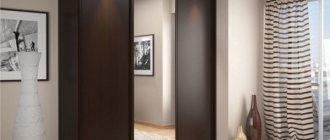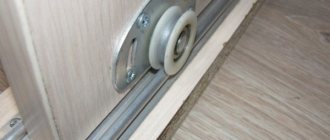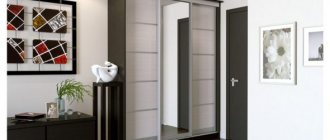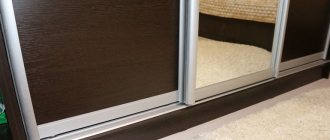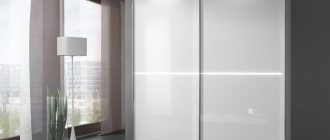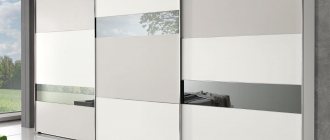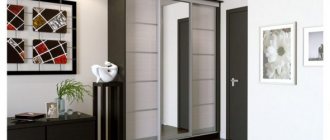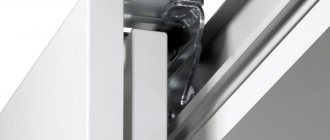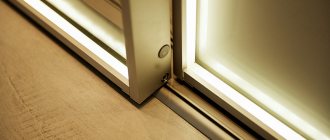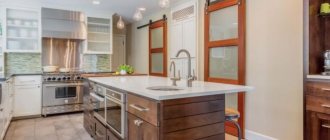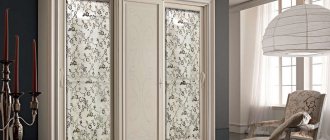The design of guides for sliding sliding doors includes various components and parts, the main function of which is to ensure the movement of various elements of furniture structures. For example, they ensure free (without jamming) sliding of the doors of various types of cabinets.
Today, two systems of guide mechanisms are most common:
- door, which include several design varieties;
- for extending box structures - table drawers, sofa trays, tabletop extensions and shelving.
Of greatest interest are systems for sliding interior sliding doors and sliding wardrobe doors.
What size can you make a closet?
When making calculations, first of all, they proceed from the size of the room or part of the space (say, a corridor or hallway) that they decided to allocate for a built-in closet.
However, there are several significant aspects that need to be taken into account. Depth The standard depth of a wardrobe with hinged doors is 60 cm. This is enough for hangers with clothes to fit freely on a regular longitudinal rod: for a convenient arrangement of outerwear, at least 55 cm is required, for light clothing - 5 cm less. If it is a closet with sliding doors, you need to add another 10 cm - that’s how much the “compartment” design will “eat”. Width The minimum width of the cabinet is not regulated, but there is no point in making it less than 40 cm - otherwise boxes with shoes will not fit. In a cabinet with a depth of less than 50 cm, you will have to replace the longitudinal rod with end rods. Calculate their number correctly: on average, 8 hangers are placed on a 40-centimeter end rod.
How to plan the interior space of a closet?
Designers recommend that before planning your closet, make a list of all the things that you will store in it, and then add another 20% “for the growth of your wardrobe.” Decide what will go on the shelf or in baskets (knitwear) and what will hang (pants, jackets). And how many things do you have in each category? Decide on the price: the internal filling of the cabinet can vary greatly in cost. Therefore, limit the budget you plan to meet in advance.
Longitudinal and end rods
Clothes hanging on hangers will take up the largest compartments. For women's clothing, we plan a box with a height of 150-160 cm. If long men's coats or raincoats will hang in the closet, set a height of 175 cm. Estimate at least approximately the number of items of clothing that will hang on hangers. You can put 5 cm on each hanger - this will be the width of the compartment (and the length of the longitudinal rod).
If you have a narrow closet with end rods, allow 60 cm of the width of the compartment on each hanger. There are usually not many end hangers - 2-3 pieces. Sometimes it’s worth making separate boxes with a bar for short items: skirts, trousers, shirts and blouses. They require a smaller height - 80-100 cm, which means they save space.
If men's trousers are hung without bending, allow 120 cm in height for them.
If you require a longitudinal rod length of more than 120 cm, provide a vertical support rod in the middle. It is positioned between the upper and lower partitions and is connected to the horizontal rod with a special coupling. This is necessary so that the longitudinal rod does not bend under the weight of things. If heavy things are hanging on hangers - fur coats, coats - the length of the bar without support should not exceed 100 cm.
Another important nuance: if the wardrobe is not built into a niche, but has side walls, do not plan a compartment with a rod immediately behind the outer wall. Make better ordinary horizontal shelves there. Sliding doors, rolling back and forth, push the side wall, creating an impact load. Horizontal shelves located close to the side plate will connect it with the rest of the supporting structures of the cabinet. One barbell will not provide such a strong connection.
Bar with lift (pantograph)
A pantograph is a special device that allows you to lower and raise a barbell. Such designs are quite expensive, but are indispensable in tall cabinets when you have to use space right under the ceiling. The pantograph will lower jackets and skirts directly into your hands, and then again remove the bar with things to an unattainable height.
Shelves Built-in wardrobes are ordered not only for clothes. On open shelves you can store almost everything (except for what needs to be hung): bed linen and knitwear, books and dishes. For clothes, you can use long shelves (80-120 cm), and for heavy books and dishes, the length of the shelf should not exceed 80 cm. A convenient distance between shelves is at least 40 cm.
If you are making a shelf longer than 80 cm, provide a vertical partition underneath it as additional support. Otherwise, the shelf may bend during use. In addition, the shelves are suitable for storing neatly folded jeans, bags, jewelry boxes, and hats. So make more shelves - they will all come in handy.
Special shelves
Wide shelves are designed at the top of the closet for blankets, rugs and bed linen. In addition, it would be nice to provide compartments for sports equipment. Think about what exactly you will store there. Four pairs of roller skates? Tennis rocket? Yoga mat? It is better to measure especially large devices in advance. At this moment you understand the advantage of a chess player over a bodybuilder. In addition, at the very top there is usually a large long shelf for suitcases, bags and travel equipment. Height - 45-50 cm.
How to keep your shelves tidy?
Clothes can slide off shallow shelves, but on long shelves they quickly turn into a shapeless heap. To prevent this from happening, make small shelves with a side or divide a long rack into separate square cells: this way, each stack of clothes will have its own cell. Maintaining order will become much easier. Another way to organize the contents of open shelves is to put everything in boxes.
Roll-out shelves
Roll-out shelves are more convenient than fixed ones - they make it easy to find and get what you need. And the distance between them may be less than between ordinary ones. True, convenience does not come cheap.
Drawers Drawers are also much more convenient than their stationary counterparts - they allow you to easily view the contents. And besides, they save cabinet space: the height of a standard drawer is 20-25 cm, the height of a shelf is 35-40 cm. The drawers better protect the contents from dust. They have one downside - they cost significantly more than shelves, so it makes sense to use them locally: for all sorts of small things that are inconvenient or impractical to store on shelves: hats, gloves, scarves and other accessories. For stockings, socks and underwear, shallow drawers are used - about 12 cm high. The most convenient drawer models are those with a transparent front wall. They allow you to see the contents of the drawer without pulling it out.
When designing a drawer and calculating its width, be sure to take into account the width of hinges on swing doors and door joints in wardrobes. If the drawer is made to the full width to the maximum, it may simply not slide out.
Organizers
Drawer dividers and organizers help prevent chaos. They can be built into the box, or they can be sold separately from it. If you hate piled-up laundry, it’s better to invest in this additional option and enjoy putting your socks into bins. Like solitaire.
How to store shoes? Special inclined shoe shelves are a very convenient way to store shoes and boots. Alas, such shelves are not very spacious. It is more rational to divide shoes into two parts: those that are worn now, and those that need to be stored - seasonal, elegant, for special occasions. Leave what you need on the shelves, and put the rest in boxes and put them in the far corners of the closet. Shoe shelves are usually designed at the bottom of the closet. Their standard length is 80-100 cm.
If shoes and bags play an important role in your life, you can allocate each item a separate place in the closet.
How to properly arrange a mezzanine?
Mezzanine is a separate space at the top of the cabinet. It’s not so easy to get there, so basically the mezzanine functions as a storage room: seasonal items and sports equipment, suitcases and dresses that “I’ll wear when I lose weight” are put away here. Inside the mezzanine, as a rule, there are no additional compartments and drawers. If the height of the cabinet allows it, you should not add separate doors to the mezzanine - this will only increase the cost of the cabinet. A separate sliding door will be especially expensive, so if you have to, it’s better to make it hinged or folding.
Sliding wardrobe or wardrobe with hinged doors?
It is not necessary to hide the contents of the sections behind large monolithic doors.
Each section and block can have its own separate swing doors. In this case, the drawers will become part of the facade. You will get quick access to things, and the front will look more interesting - if, of course, you have planned the design aesthetically. Shelves and drawers hidden behind large doors can be arranged based solely on logic rather than aesthetics. Additionally, keep in mind that wardrobe doors “eat up” 10 cm of space, while a hinged door is only the thickness of a chipboard or MDF board (10 or 18 mm).
And most importantly, solid facades will cost less.
What it is
When planning to order a wardrobe, you have to pay attention to a wide list of features and characteristics. One of the most important is rightly considered to be the system used for opening sliding doors.
[adv1]
Hanging systems are a set of sliding doors, which are equipped with bottom-supporting or top-supporting rollers. They consist mainly of aluminum profiles, onto which a special coating is applied.
The system also includes closers. They are needed for more accurate, smooth and quiet closing of doors. The appearance of such structures is due to living conditions when there is not enough space in apartments, and it is necessary to make the most useful use of the available space.
Mirror, plinth and lighting
Mirror The most popular way to place a mirror in a closet is to make the doors mirrored. You can cover the closet with mirrors completely or partially. It is ergonomic: the mirror does not take up additional space, and reflective surfaces add shine, light and volume to the interior. If you are not a fan of large mirror surfaces in the interior, mirror the inner surfaces of the doors. True, this method is only suitable for swing structures. Two open doors with mirrors inside will provide the effect of a dressing table: you can see yourself both in front and behind.
Base
This element of the built-in wardrobe is useful if you have an uneven floor, which means there may be problems with doors mounted to the very bottom. Coupe doors will slide downhill, and you won’t be able to install a guide on bumps. Swinging doors can also warp, in addition, there will be unsightly gaps between the door and the floor. The plinth allows you to level the lower level of the cabinet, eliminating these problems.
Lighting Additional lighting of the closet is effective, practical, but not at all necessary. Using lighting, you can make open shelves more interesting and the space behind glass doors more mysterious. After all, illuminated shelves make it easier to find what you need. Mounting lighting inside sections makes sense if you have open shelves and want a beautiful decorative effect. Lighting hidden inside one shelf will not reach another compartment. If you want to illuminate the contents of the closet so as not to rummage through things in the dark, install lamps in the canopy. Don't forget to leave a gap between the canopy and the top border of the swing doors so they don't get caught. The transformer for built-in lamps is usually installed on the roof of the cabinet.
Installation method
The design of the sliding mechanism determines the type of guide and installation method.
Suspension
Suspended - the main profile along which the rollers move is fixed on the upper horizontal surface or on the walls.
An auxiliary profile can be installed on the floor to limit the lateral movement of the door, rattling and hitting the door leaves against each other.
Advantages:
- since the suspension system uses lightweight doors, it is possible to attach the roller system directly to the door leaf;
- savings on frameless installation;
- silent movement;
- easy installation.
Sliding doors with a hanging system
Disadvantage - the method is only suitable for lightweight doors.
Difficulty arises only in the case of installation of glass sections in which holes are drilled for fasteners
Support
Support - a guide profile for the rollers is attached to the floor, and an auxiliary one is installed on the ceiling.
The advantage is the ability to use canvas of any weight.
Flaws:
- open lower profile requires frequent removal of dust and debris;
- The hidden bottom guide complicates installation.
To prevent the threshold from interfering, you can install the lower profile flush with the floor, but this violates the integrity of the floor.
Cabinet structure with support rail system
How can you reduce the cost of a built-in wardrobe?
Reducing the price of a cabinet is, of course, a way of compromises, but not all of them will be painful for you. So what can you give up? If you are planning a wardrobe, replace the expensive aluminum system with a cheap steel one. It is, of course, less reliable, but if you do not look too far ahead, it will do just fine. The service life of an aluminum system is 20 years, while that of a steel system is on average 5-7. Well, the steel one is noisier. Another saving resource is the number and design of doors. If you replace narrow doors with fewer wide ones, it will be cheaper. In some places you can abandon doors altogether - make a combined façade with open shelves or install hinged doors instead of compartment doors.
You can reduce the cost of a cabinet by using the materials used. Instead of the expensive chipboard that goes on the facade, use a white or thinner board inside. It is usually significantly cheaper. If you plan the shelves correctly, their load-bearing capacity will not deteriorate. Full-extension drawers are convenient, but quite expensive. You can replace ball bearing guides with roller guides. Yes, the drawers will not slide as smoothly and they will not be able to be pulled out completely, but this is not always important. Or give up drawers in favor of regular shelves.
You can save on shelf fastenings. Instead of invisible eccentrics that pull shelves and sides together, use regular corners. In essence, there are no inconveniences from them - on the contrary: if you want, you can rearrange the shelves differently. The only case when it is impossible to refuse eccentrics is when the shelves serve as stiffening ribs that hold the cabinet structure, for example, in the outer section with an open, non-built-in side panel.
Information provided by the site mebeldok.com
Guides
When choosing a profile for sliding doors, regardless of the type of sliding system, the main attention is paid to the material of its manufacture. Today they are made from various materials.
The plastic guide profile has the lowest cost, but has a significant drawback - relatively poor reliability and short service life. Today, combined rail supports are mainly used, in which a plastic profile has a metal supporting surface for the rollers.
Steel rail supports are highly reliable. Their price is low and depends primarily on the brand. Moreover, sometimes the cost is clearly too high compared to the performance properties and ease of installation.
Rail supports of all well-known furniture brands are made from aluminum, including circular guides for sliding doors. They have the best technical characteristics and high ergonomic and aesthetic properties. Thanks to their optimized properties, they can be used to install sliding panels of any weight and width, up to five meters in height. The only drawback is the significant cost.
Depending on the type of hanging option and the number of sashes, rail guides can be one-, two- or three-lane. In addition, the supports themselves are made straight or curved.
To increase decorativeness and aesthetics, almost all elements and parts are anodized, chrome-plated or painted using powder coating technology. The type of tinting can be anything, from traditional silver, gold or wood texture, and up to “antique bronze”.
